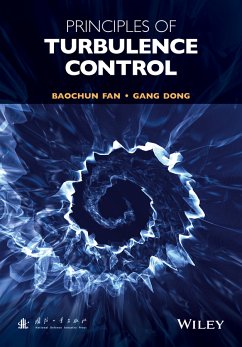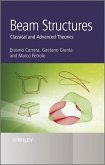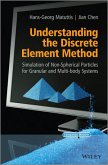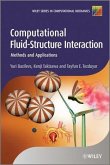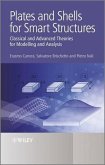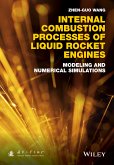

Alle Infos zum eBook verschenken

- Format: ePub
- Merkliste
- Auf die Merkliste
- Bewerten Bewerten
- Teilen
- Produkt teilen
- Produkterinnerung
- Produkterinnerung

Hier können Sie sich einloggen

Bitte loggen Sie sich zunächst in Ihr Kundenkonto ein oder registrieren Sie sich bei bücher.de, um das eBook-Abo tolino select nutzen zu können.
This book introduces the mathematical techniques for turbulence control in a form suitable for inclusion in an engineering degree program at both undergraduate and postgraduate levels whilst also making it useful to researchers and industrial users of the concepts. It uses a mix of theory, computation and experimental results to present and illustrate the methodologies. It is based on the three part structure, wall turbulence, open loop control and feedback control with emphasis on optimal control methodologies. The book also includes an introduction of basic principles and fundamentals…mehr
- Geräte: eReader
- mit Kopierschutz
- eBook Hilfe
- Größe: 42.39MB
![Principles of Turbulence Control (eBook, PDF) Principles of Turbulence Control (eBook, PDF)]() Baochun FanPrinciples of Turbulence Control (eBook, PDF)128,99 €
Baochun FanPrinciples of Turbulence Control (eBook, PDF)128,99 €![Heat Transfer 1 (eBook, ePUB) Heat Transfer 1 (eBook, ePUB)]() Michel LedouxHeat Transfer 1 (eBook, ePUB)139,99 €
Michel LedouxHeat Transfer 1 (eBook, ePUB)139,99 €![Beam Structures (eBook, ePUB) Beam Structures (eBook, ePUB)]() Erasmo CarreraBeam Structures (eBook, ePUB)89,99 €
Erasmo CarreraBeam Structures (eBook, ePUB)89,99 €![Understanding the Discrete Element Method (eBook, ePUB) Understanding the Discrete Element Method (eBook, ePUB)]() Hans-Georg MatuttisUnderstanding the Discrete Element Method (eBook, ePUB)128,99 €
Hans-Georg MatuttisUnderstanding the Discrete Element Method (eBook, ePUB)128,99 €![Computational Fluid-Structure Interaction (eBook, ePUB) Computational Fluid-Structure Interaction (eBook, ePUB)]() Yuri BazilevsComputational Fluid-Structure Interaction (eBook, ePUB)102,99 €
Yuri BazilevsComputational Fluid-Structure Interaction (eBook, ePUB)102,99 €![Plates and Shells for Smart Structures (eBook, ePUB) Plates and Shells for Smart Structures (eBook, ePUB)]() Erasmo CarreraPlates and Shells for Smart Structures (eBook, ePUB)98,99 €
Erasmo CarreraPlates and Shells for Smart Structures (eBook, ePUB)98,99 €![Internal Combustion Processes of Liquid Rocket Engines (eBook, ePUB) Internal Combustion Processes of Liquid Rocket Engines (eBook, ePUB)]() Zhen-Guo WangInternal Combustion Processes of Liquid Rocket Engines (eBook, ePUB)123,99 €
Zhen-Guo WangInternal Combustion Processes of Liquid Rocket Engines (eBook, ePUB)123,99 €-
-
-
Dieser Download kann aus rechtlichen Gründen nur mit Rechnungsadresse in A, B, BG, CY, CZ, D, DK, EW, E, FIN, F, GR, HR, H, IRL, I, LT, L, LR, M, NL, PL, P, R, S, SLO, SK ausgeliefert werden.
- Produktdetails
- Verlag: John Wiley & Sons
- Seitenzahl: 400
- Erscheinungstermin: 23. März 2016
- Englisch
- ISBN-13: 9781118718049
- Artikelnr.: 44870633
- Verlag: John Wiley & Sons
- Seitenzahl: 400
- Erscheinungstermin: 23. März 2016
- Englisch
- ISBN-13: 9781118718049
- Artikelnr.: 44870633
Analysis and Spectral Method 3 1.1 Statistical Analysis and Spectral Method
3 1.1.1 Average Value 3 1.1.2 Probability Density and Statistical Moments 5
1.1.3 Correlation Function 9 1.2 Statistical Analysis of Turbulence 11
1.2.1 Reynolds Stress and Turbulent Kinetic Energy 11 1.2.2
Variable-Interval Time Average Method 13 1.3 Fourier Transform and Spectrum
16 1.3.1 Harmonic Wave 16 1.3.2 Fourier Transform 18 1.3.3 Energy Spectrum
22 1.4 Spectral Series Expansion of Function 22 1.4.1 Orthogonal Basis 22
1.4.2 Fourier Series 23 1.4.3 Chebyshev Polynomials 24 1.5 Fundamentals of
Spectral Methods 26 1.5.1 Fundamental Concepts 26 1.5.2 Fourier-Galerkin
Method 29 1.5.3 Chebyshev-Tau Method 31 1.5.4 Helmholtz Equation 34 1.6
Spectral Method of Navier-Stokes Equations 38 1.6.1 Time Integration Method
38 1.6.2 Spectral Method based on Time Marching Algorithms (1) 41 1.6.3
Spectral Method based on Time Marching Algorithms (2) 50 1.6.4 Spectral
Method based on Time-Split Method 52 1.7 Closed Remarks 54 References 55 2
Wall Turbulence and Its Coherent Structure 57 2.1 Boundary Layer Flow and
Flow Stability 58 2.1.1 Boundary Layer Flow 58 2.1.2 Flow Stability 59
2.1.3 Linear Stability Theory of Flow 61 2.2 Transition of Boundary Layer
Flow 63 2.2.1 Basic Process 63 2.2.2 Receptivity Stage 64 2.2.3 Linear
Instability and Transient Growth 68 2.2.4 Nonlinear Instability and
Turbulent Spot 71 2.2.5 Bypass Transition 75 2.3 Coherent Structure of Wall
Turbulence 77 2.3.1 Statistical Properties of Near-Wall Turbulence 78 2.3.2
Structural Features and Identification of Streak 82 2.3.3 Structural
Features and Identification of Vortex 83 2.4 Formation and Evolution of a
Coherent Structure 89 2.4.1 Formation and Instability of Streak 89 2.4.2
Formation of a Vortex Structure 92 2.4.3 A Novel Coherent Motion: Soliton
and Its Relevant Structures 97 2.5 Bursting and Self-Sustaining of Wall
Turbulence 102 2.5.1 Bursting Event 103 2.5.2 Self-Sustaining of a Coherent
Structure 105 2.6 Closed Remarks 107 References 109 Part II CONTROL OF WALL
TURBULENCE 3 Control of Turbulence with Active Wall Motion 115 3.1 Stokes
Second Problem 118 3.2 Experiments of Wall Turbulence with Spanwise Wall
Oscillation 121 3.2.1 Incompressible Flow with Spanwise Wall Oscillation
121 3.2.2 Compressible Flow with Spanwise Wall Oscillation 127 3.3
Numerical Simulation of Wall Turbulence with Spanwise Wall Oscillation 136
3.3.1 Wall Turblence with Spanwise Wall Oscillation 136 3.3.2 Control
Mechanism of Spanwise Wall Oscillation 139 3.3.3 Wall Turbulence with
Spanwise Traveling Wave on Wavy Wall 147 3.3.4 Wall Turbulence with
Streamwise Traveling Wave on Wavy Wall 150 3.4 Deformed Wall 153 3.4.1
Shape Memory Alloy 155 3.4.2 Piezoceramics 156 3.4.3 Magnet 157 3.4.4 Cam
Mechanism 158 3.5 Experiments of Wall Turbulence with Deformed Wall 158
3.5.1 Incompressible Flow with Deformed Wall 158 3.5.2 Compressible Flow
with Deformed Wall 160 3.6 Numerical Simulation of Wall Turbulence with
Deformed Wall 164 3.6.1 Wall Turbulence with Streamwise-Traveling Surface
Deformation Wave 164 3.6.2 Wall Turbulence with Sinusoidally Deformed Wall
173 3.6.3 Wall Turbulence with Opposition Wall Deformation Control 177
3.6.4 Control Mechanism of Deformed Wall 188 3.7 Closed Remarks 192
References 193 4 Control of Turbulence by Lorentz Force 195 4.1 Lorentz
Force 197 4.2 Experiments of Wall Turbulence with Spanwise Lorentz Force
200 4.2.1 Control with Uniform Spanwise Oscillating Lorentz Force 200 4.2.2
Control with Wavy Lorentz Force 206 4.3 Numerical Simulation of Wall
Turbulence with Spanwise Lorentz Force 214 4.3.1 Spanwise Lorentz Force 214
4.3.2 Generalized Stokes Layer Induced by Oscillating Lorentz Force 216
4.3.3 Control with Spanwise Oscillating Lorentz Force 219 4.3.4 Control
with Wavy Lorentz Force 239 4.4 Wall Turbulence with Wall-Normal Lorentz
Force 260 4.4.1 Three-Dimensional Lorentz Force Field 260 4.4.2 Experiments
on Wall Normal EM Actuator Tile 261 4.4.3 Numerical Simulation of Wall
Turbulence with Normal Lorentz Force 263 4.5 Closed Remarks 265 References
267 Part III OPTIMAL FLOW CONTROL 5 Linear Optimal Flow Control 271 5.1
Optimal Control 273 5.1.1 Introduction 273 5.1.2 Optimal Control for
Ordinary Differential Equations 277 5.2 Optimal Control of Linear Quadratic
Systems 280 5.2.1 Linear Quadratic Optimal Control 280 5.2.2 Discrete
Linear Quadratic Systems 287 5.2.3 Linear Quadratic Gaussian (LQG) Control
in the Presence of Noise 288 5.3 Linear Process in Near-Wall Turbulent Flow
290 5.4 Linear Optimal Control of Two-Dimensional Flow 294 5.4.1
Linearization of Navier-Stokes Equations 294 5.4.2 Spectral Decomposition
of Linearized Flow 296 5.4.3 Standard State-Space Representations of
Linearized Flow 299 5.4.4 Linear Optimal Control of Channel Flow 302 5.5
Linear Optimal Control of Three-Dimensional Flow 305 5.6 Closed Remarks 309
References 310 6 Nonlinear Optimal Flow Control 313 6.1 Fundamentals of
Optimal Flow Control 314 6.1.1 Closed-Loop Flow Control 314 6.1.2 Cost
Functional 315 6.1.3 Fréchet Differential 316 6.2 Spectrum-based Suboptimal
Control 316 6.2.1 Control of Channel Flow 316 6.2.2 Control of
Backward-Facing Step Flow 323 6.2.3 Control of Cylinder Flow 329 6.3
Adjoint-based Suboptimal Control 341 6.3.1 Fundamentals of Adjoint-based
Suboptimal Control 341 6.3.2 Adjoint-based Suboptimal Control 344 6.3.3
Near-Wall Turbulence Controlled by Blowing-Suction Wall 347 6.3.4 Cylinder
Flow Controlled by Lorentz Force 348 6.4 Neural Network in Flow Control 360
6.4.1 Neural Network 360 6.4.2 Near-Wall Turbulence Controlled by
Blowing-Suction Wall 361 6.4.3 Near-Wall Turbulence Controlled by Deformed
Wall 367 6.4.4 Near-Wall Turbulence Controlled by Lorentz Force 370 6.5
Closed Remarks 372 References 373 Index 375
Analysis and Spectral Method 3 1.1 Statistical Analysis and Spectral Method
3 1.1.1 Average Value 3 1.1.2 Probability Density and Statistical Moments 5
1.1.3 Correlation Function 9 1.2 Statistical Analysis of Turbulence 11
1.2.1 Reynolds Stress and Turbulent Kinetic Energy 11 1.2.2
Variable-Interval Time Average Method 13 1.3 Fourier Transform and Spectrum
16 1.3.1 Harmonic Wave 16 1.3.2 Fourier Transform 18 1.3.3 Energy Spectrum
22 1.4 Spectral Series Expansion of Function 22 1.4.1 Orthogonal Basis 22
1.4.2 Fourier Series 23 1.4.3 Chebyshev Polynomials 24 1.5 Fundamentals of
Spectral Methods 26 1.5.1 Fundamental Concepts 26 1.5.2 Fourier-Galerkin
Method 29 1.5.3 Chebyshev-Tau Method 31 1.5.4 Helmholtz Equation 34 1.6
Spectral Method of Navier-Stokes Equations 38 1.6.1 Time Integration Method
38 1.6.2 Spectral Method based on Time Marching Algorithms (1) 41 1.6.3
Spectral Method based on Time Marching Algorithms (2) 50 1.6.4 Spectral
Method based on Time-Split Method 52 1.7 Closed Remarks 54 References 55 2
Wall Turbulence and Its Coherent Structure 57 2.1 Boundary Layer Flow and
Flow Stability 58 2.1.1 Boundary Layer Flow 58 2.1.2 Flow Stability 59
2.1.3 Linear Stability Theory of Flow 61 2.2 Transition of Boundary Layer
Flow 63 2.2.1 Basic Process 63 2.2.2 Receptivity Stage 64 2.2.3 Linear
Instability and Transient Growth 68 2.2.4 Nonlinear Instability and
Turbulent Spot 71 2.2.5 Bypass Transition 75 2.3 Coherent Structure of Wall
Turbulence 77 2.3.1 Statistical Properties of Near-Wall Turbulence 78 2.3.2
Structural Features and Identification of Streak 82 2.3.3 Structural
Features and Identification of Vortex 83 2.4 Formation and Evolution of a
Coherent Structure 89 2.4.1 Formation and Instability of Streak 89 2.4.2
Formation of a Vortex Structure 92 2.4.3 A Novel Coherent Motion: Soliton
and Its Relevant Structures 97 2.5 Bursting and Self-Sustaining of Wall
Turbulence 102 2.5.1 Bursting Event 103 2.5.2 Self-Sustaining of a Coherent
Structure 105 2.6 Closed Remarks 107 References 109 Part II CONTROL OF WALL
TURBULENCE 3 Control of Turbulence with Active Wall Motion 115 3.1 Stokes
Second Problem 118 3.2 Experiments of Wall Turbulence with Spanwise Wall
Oscillation 121 3.2.1 Incompressible Flow with Spanwise Wall Oscillation
121 3.2.2 Compressible Flow with Spanwise Wall Oscillation 127 3.3
Numerical Simulation of Wall Turbulence with Spanwise Wall Oscillation 136
3.3.1 Wall Turblence with Spanwise Wall Oscillation 136 3.3.2 Control
Mechanism of Spanwise Wall Oscillation 139 3.3.3 Wall Turbulence with
Spanwise Traveling Wave on Wavy Wall 147 3.3.4 Wall Turbulence with
Streamwise Traveling Wave on Wavy Wall 150 3.4 Deformed Wall 153 3.4.1
Shape Memory Alloy 155 3.4.2 Piezoceramics 156 3.4.3 Magnet 157 3.4.4 Cam
Mechanism 158 3.5 Experiments of Wall Turbulence with Deformed Wall 158
3.5.1 Incompressible Flow with Deformed Wall 158 3.5.2 Compressible Flow
with Deformed Wall 160 3.6 Numerical Simulation of Wall Turbulence with
Deformed Wall 164 3.6.1 Wall Turbulence with Streamwise-Traveling Surface
Deformation Wave 164 3.6.2 Wall Turbulence with Sinusoidally Deformed Wall
173 3.6.3 Wall Turbulence with Opposition Wall Deformation Control 177
3.6.4 Control Mechanism of Deformed Wall 188 3.7 Closed Remarks 192
References 193 4 Control of Turbulence by Lorentz Force 195 4.1 Lorentz
Force 197 4.2 Experiments of Wall Turbulence with Spanwise Lorentz Force
200 4.2.1 Control with Uniform Spanwise Oscillating Lorentz Force 200 4.2.2
Control with Wavy Lorentz Force 206 4.3 Numerical Simulation of Wall
Turbulence with Spanwise Lorentz Force 214 4.3.1 Spanwise Lorentz Force 214
4.3.2 Generalized Stokes Layer Induced by Oscillating Lorentz Force 216
4.3.3 Control with Spanwise Oscillating Lorentz Force 219 4.3.4 Control
with Wavy Lorentz Force 239 4.4 Wall Turbulence with Wall-Normal Lorentz
Force 260 4.4.1 Three-Dimensional Lorentz Force Field 260 4.4.2 Experiments
on Wall Normal EM Actuator Tile 261 4.4.3 Numerical Simulation of Wall
Turbulence with Normal Lorentz Force 263 4.5 Closed Remarks 265 References
267 Part III OPTIMAL FLOW CONTROL 5 Linear Optimal Flow Control 271 5.1
Optimal Control 273 5.1.1 Introduction 273 5.1.2 Optimal Control for
Ordinary Differential Equations 277 5.2 Optimal Control of Linear Quadratic
Systems 280 5.2.1 Linear Quadratic Optimal Control 280 5.2.2 Discrete
Linear Quadratic Systems 287 5.2.3 Linear Quadratic Gaussian (LQG) Control
in the Presence of Noise 288 5.3 Linear Process in Near-Wall Turbulent Flow
290 5.4 Linear Optimal Control of Two-Dimensional Flow 294 5.4.1
Linearization of Navier-Stokes Equations 294 5.4.2 Spectral Decomposition
of Linearized Flow 296 5.4.3 Standard State-Space Representations of
Linearized Flow 299 5.4.4 Linear Optimal Control of Channel Flow 302 5.5
Linear Optimal Control of Three-Dimensional Flow 305 5.6 Closed Remarks 309
References 310 6 Nonlinear Optimal Flow Control 313 6.1 Fundamentals of
Optimal Flow Control 314 6.1.1 Closed-Loop Flow Control 314 6.1.2 Cost
Functional 315 6.1.3 Fréchet Differential 316 6.2 Spectrum-based Suboptimal
Control 316 6.2.1 Control of Channel Flow 316 6.2.2 Control of
Backward-Facing Step Flow 323 6.2.3 Control of Cylinder Flow 329 6.3
Adjoint-based Suboptimal Control 341 6.3.1 Fundamentals of Adjoint-based
Suboptimal Control 341 6.3.2 Adjoint-based Suboptimal Control 344 6.3.3
Near-Wall Turbulence Controlled by Blowing-Suction Wall 347 6.3.4 Cylinder
Flow Controlled by Lorentz Force 348 6.4 Neural Network in Flow Control 360
6.4.1 Neural Network 360 6.4.2 Near-Wall Turbulence Controlled by
Blowing-Suction Wall 361 6.4.3 Near-Wall Turbulence Controlled by Deformed
Wall 367 6.4.4 Near-Wall Turbulence Controlled by Lorentz Force 370 6.5
Closed Remarks 372 References 373 Index 375
